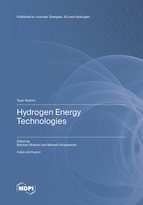Topic Menu
► Topic MenuTopic Editors

Hydrogen Energy Technologies

A printed edition is available here.
Topic Information
Dear Colleagues,
The scene is being set for hydrogen to be a major player to decarbonise our modern economy. With increasing level of investment driven by the demand side, the hydrogen industry is now positioning itself towards mass production in the coming years that would significantly drive down costs even faster than what we have witnessed in the past couple of decades. In line with all these developments, research and innovation in this field are expanding at a rapid rate, and we in the Energies journal are committed to facilitating the communication of high-quality studies in this field. This topic focuses on the latest fundamentals and applied innovations in the field of hydrogen energy covering the production, storage, distribution, and utilisation of hydrogen energy in various stationary and mobile applications. The topic includes but is not limited to:
- Hydrogen production methods;
- Hydrogen distribution;
- Novel hydrogen storage solutions;
- Large-scale hydrogen-based energy storage;
- Integrated renewable hydrogen systems;
- Fuel cells and electrolysers;
- Hydrogen systems modelling and optimisation (including numerical and analytical modelling, computational chemistry, etc.);
- Hydrogen system components and design (including MEA, catalyst layer, electrodes, GDL, membrane, bipolar plates, flow field, etc.);
- Hydrogen system operation and optimisation;
- Hydrogen for stationary and mobile applications;
- Control solutions for hydrogen systems;
- Hydrogen system/component manufacturing;
- Advanced hydrogen materials;
- Thermofluid modelling of hydrogen systems;
- Hydrogen economy;
- Hydrogen safety.
Prof. Dr. Bahman Shabani
Dr. Mahesh Suryawanshi
Topic Editors
Keywords
- hydrogen energy
- fuel cell
- electrolyser
- energy storage
- hydrogen production
- hydrogen utilisation
- renewable hydrogen
- hydrogen materials
- hydrogen systems
Participating Journals
| Journal Name | Impact Factor | CiteScore | Launched Year | First Decision (median) | APC |
|---|---|---|---|---|---|

Energies
|
3.2 | 5.5 | 2008 | 16.1 Days | CHF 2600 |

Sci
|
- | 3.1 | 2019 | 47.7 Days | CHF 1200 |

Hydrogen
|
- | - | 2020 | 14.4 Days | CHF 1000 |

MDPI Topics is cooperating with Preprints.org and has built a direct connection between MDPI journals and Preprints.org. Authors are encouraged to enjoy the benefits by posting a preprint at Preprints.org prior to publication:
- Immediately share your ideas ahead of publication and establish your research priority;
- Protect your idea from being stolen with this time-stamped preprint article;
- Enhance the exposure and impact of your research;
- Receive feedback from your peers in advance;
- Have it indexed in Web of Science (Preprint Citation Index), Google Scholar, Crossref, SHARE, PrePubMed, Scilit and Europe PMC.


